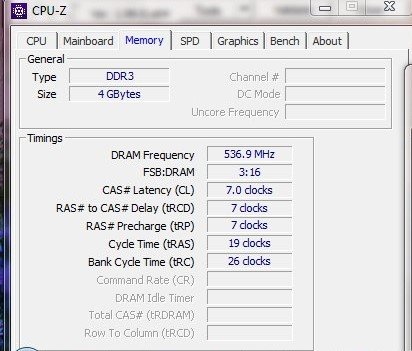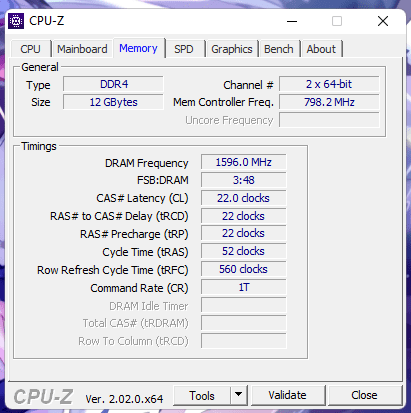Comparing: DDR3 1066MHz SODIMM vs DDR4 3200MHz SODIMM
In this comparison, we analyze two Memory: DDR3 1066MHz SODIMM and DDR4 3200MHz SODIMM, using synthetic benchmark tests to evaluate their overall performance. This side-by-side comparison helps users understand which hardware delivers better value, speed, and efficiency based on standardized testing. Whether you're building a new system or upgrading an existing one, this benchmark-driven evaluation offers valuable insights to guide your decision.

DDR3 1066MHz SODIMM
| Type: | Memory |
|---|---|
| Model: | DDR3 1066MHz SODIMM |
| Freq: | 1066MHz |

DDR4 3200MHz SODIMM
| Type: | Memory |
|---|---|
| Model: | DDR4 3200MHz SODIMM |
| Freq: | 3200MHz |
Specification Comparison Table
This specification comparison presents technical details of several devices or components to help you understand the key differences between each option. Use this table as a reference to determine which device best suits your needs.
| Specification | DDR3 1066MHz SODIMM | DDR4 3200MHz SODIMM |
|---|---|---|
| Model | DDR3 1066MHz SODIMM | DDR4 3200MHz SODIMM |
| Frequency | 1066MHz | 3200MHz |
Submission Comparison Table
This submission comparison table displays the number and details of benchmark data submissions from various devices or components. This information helps you understand the performance based on the benchmarks that have been tested, as well as providing an overview of the consistency and popularity of the available benchmark results.
| No. | Benchmark Software | DDR3 1066MHz SODIMM | DDR4 3200MHz SODIMM |
|---|---|---|---|
| 1 | PYPrime - 2B with BenchMate |
2min, 3sec, 3ms |
16sec, 394ms |
| 2 | AIDA64 - Memory Read |
5529 points |
42265 points |
| 3 | Memory Frequency |
536.9 MHz |
1596.0 MHz |
Submission Comparison Chart
This chart visualizes the benchmark scores comparison between two hardware devices based on submitted data.
Media Gallery
A collection of photos of tested hardware. These images can help you identify the physical form, model, and variant of the hardware in question. These photos are from our own documentation, and if they are not available we may not be able to document them.
About Hardware DDR3 1066MHz SODIMM
DDR3 1066MHz SODIMM is a type of low-medium speed RAM that is still widely used in older generation laptops or devices with limited specifications. With the SODIMM (Small Outline Dual In-line Memory Module) form factor, this module is specifically designed for compact devices such as notebooks and mini PCs. The configuration in this test uses two pieces of RAM from different brands, ADATA and Micron, each with a capacity of 2GB, bringing the total memory to 4GB in single-channel mode.
Although the RAM modules have a native frequency of 1600MHz, the system sets the speed limit to 1066MHz due to the limitations of the AMD E1-1200 processor used in the HP 1000 1b05AU laptop. This is a clear example of how RAM speed also depends on CPU and motherboard architecture support. The memory timings were recorded at 7-7-7-19, which indicates a fairly tight latency configuration for the entry-level DDR3 class, providing a balance between stability and efficiency.
Tests were conducted in Windows 7 and Windows 8 operating systems, which are quite common on devices with these specifications. Based on synthetic performance testing using PYPrime 2B (via BenchMate), the completion time was recorded at 2 minutes 3 seconds 3 milliseconds, reflecting the system's capability in handling light to medium computing workloads. Meanwhile, a benchmark using AIDA64 showed a Memory Read score of 5529 points, which is quite good for this class of frequency-limited DDR3 RAM.
Overall, this combination of DDR3 1066MHz SODIMMs with a total capacity of 4GB is still reliable for running light operating systems, browsing, and other basic computing tasks on older generation laptops. While it can't match the performance of a modern DDR4 or DDR5, this RAM is still relevant for users who want to revive an older laptop for light use or simply as a backup device. With its affordable price and wide availability in the market, DDR3 SODIMM is a great choice for a cost-effective and functional upgrade.
Device test (testbed)
Device: HP 1000 1b05au
CPU: AMD E1-1200
RAM: 2x2GB Single Channel (limit from CPU)
OS: Windows 7, Windows 8
Wednesday, 12 December 2012 14:27:27 | Update: 1 month ago
About Hardware DDR4 3200MHz SODIMM
DDR4 3200MHz SODIMMs are the latest generation of memory modules designed to deliver high speed, better power efficiency and responsive multitasking performance on modern laptop devices. In this test, the RAM configuration consisted of 8GB V-GeN DDR4 3200MHz SODIMM and 4GB DDR4 3200MHz soldered on-board (unknown brand), resulting in a total capacity of 12GB in dual channel mode, significantly increasing memory bandwidth and overall system performance.
The test was conducted using a Lenovo IdeaPad Slim 3i 14ITL6 laptop, powered by an Intel Core i5-1135G7 processor, NVIDIA MX350 graphics, and Windows 11 Home operating system. This configuration represents mid-range usage commonly found on daily productivity laptops, whether for office, multimedia, or light editing.
The V-GeN DDR4 3200MHz SODIMM module comes with a timing configuration of 22-22-22-52-1T, which although not in the low-latency category for the high-performance class, is still capable of providing optimal stability and efficiency in daily use. When tested using the PYPrime 2B benchmark application via BenchMate, the memory managed to complete a large calculation in just 16 seconds and 394 milliseconds, reflecting the good coordination between the memory and processor in handling heavy computing workloads. In addition, testing using AIDA64 Memory Read showed a score of 42,265 points, indicating a high data read speed. These results also reinforce the effectiveness of the system's dual channel configuration, where the combination of one 8GB module and one 4GB module proved to significantly optimize memory bandwidth in handling both large data transfer processes and heavy multitasking.
DDR4 at 3200MHz is now a common standard in new laptops due to its ability to handle modern applications and multitasking operating systems such as Windows 11. The combination of 12GB capacity and high frequency makes this configuration ideal for users looking to increase productivity without having to replace their entire system, simply by adding or combining a single piece of quality SODIMM RAM such as from V-GeN.
For users who require speed of response, power efficiency and multitasking capabilities, DDR4 3200MHz SODIMM is a great choice. Its wide availability and high compatibility with both Intel and AMD processors make it highly versatile for a variety of purposes, from students, professionals, to casual gamers.
Device test (testbed):
Device: Lenovo IdeaPad Slim 3i 14ITL6
Specs: i5-1135G7, NVIDIA MX350, 12GB RAM 3200MHz (4+8), 512GB NVMe SSD, Windows 11 Home
Friday, 06 August 2021 05:58:27 | Update: 1 month ago


